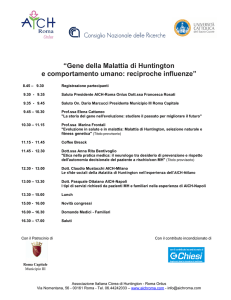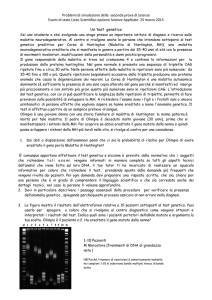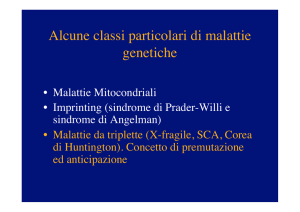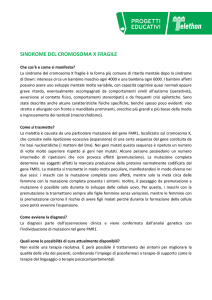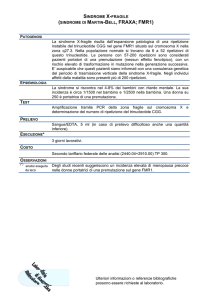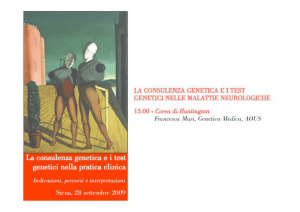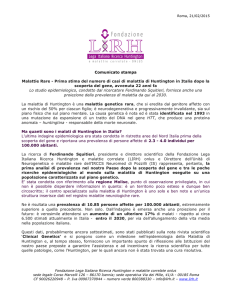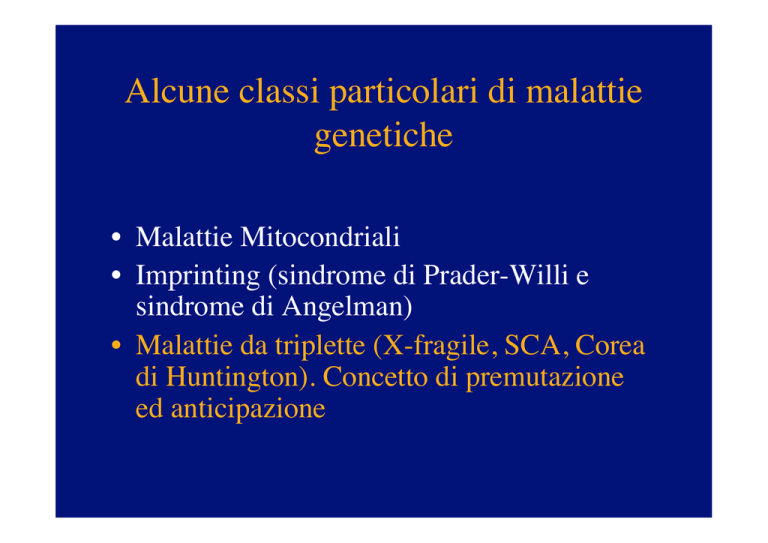
Alcune classi particolari di malattie
genetiche
• Malattie Mitocondriali
• Imprinting (sindrome di Prader-Willi e
sindrome di Angelman)
• Malattie da triplette (X-fragile, SCA, Corea
di Huntington). Concetto di premutazione
ed anticipazione
Genetica mendeliana classica:
Le mutazioni sono stabili e vengono trasmesse
invariate da una generazione all’altra.
ECCEZIONE:
Mutazioni instabili dovute ad espansione di
DNA ripetuto Triplette trinucleotidiche in tandem sono abbastanza comuni
nel nostro genoma
Ci sono 10 possibili triplette:
AAC/GTT ACT/AGT
AAG/CTT AGG/CCT
AAT/ATT ACT/GAT
ACC/GGT CAG/CTG
ACG/ CGT CCG/CGG
Alcune triplette CAG/CTG (glutamina) e CCG/GGC mostrano
un comportamento anomalo: al di sopra di una certa soglia
diventano estremamente instabili in mitosi e meiosi
MUTAZIONI DA DNA INSTABILE
……..CGGCGGCGG……..!
..…CGGCGGCGGCGGCGGCGGCGGCGG…..!
……..CAGCAGCAG……..!
..…CAGCAGCAGCAGCAGCAGCAGCAG…..!
AMPLIFICAZIONE DI TRIPLETTE DI DNA CHE AVVIENE
DI GENERAZIONE IN GENERAZIONE NUOVO MECCANISMO DI MUTAZIONE E DI TRASMISSIONE GENETICA
Meccanismo tripletta
Modello 1 “slippage”
(a) Expansion as a consequence of DNA polymerase slippage. During replication
of a trinucleotide repeat tract (repeats indicated by rectangles), the primer and
template strands transiently dissociate (step 1). Reassociation occurs with a DNA
loop formed in the primer strand (step 2). Continued synthesis with no repair of
the loop (step 3) would result in an addition of repeats. We show the loop
stabilized by formation of a hairpin structure. Meccanismo tripletta
Modello 2.
Errato posizionamento
frammento di Okazaki
(b) Expansion of a trinucleotide repeat tract as a consequence of displacement of
an Okazaki fragment. In this model, synthesis displaces the 5′end (indicated
by ) of the neighboring Okazaki fragment (step 1′). The displaced strand folds
back on itself to form a hairpin (step 2′) and is resistant to processing by FEN1
endonuclease (8). Continued synthesis and ligation (step 3′) results in an
expanded trinucleotide repeat tract.
Ci dovremmo aspettare sia espansioni
che riduzioni di triplette."
"
"
C’e’ una tendenza all’espansione!"
Genetica delle malattie da triplette:
• Concetto di premutazione
• Instabilita’ somatica e germinale
• Anticipazione
Concetto di Premutazione
Ripetute al limite superiore del normale, che di per se’ non
causano la malattia, ma possono espandersi e diventare
patogenetiche nella generazione successiva 22 29
82 22 83
>200
22 90
>200
29 80
~500
Instabilita’ genetica
normal: 5 - 37
premutation: 38 - 50 (minimal transition threshold: 35)
very late onset: 42 - 180
adult onset: few - several hundreds
congenital disease: greater than approx. 1000
Generic Pedigree of a Dominantly Inherited
Due to CAG Repeat Instability
SCA1
INSTABILITA’ GERMINALE
Instabilita’ germinale
Origine parentale della tripletta può
essere importante:"
" "
• La trasmissione paterna ha un rischio aumentato di
espansione nel caso delle malattie da poliglutamine (CAG
codifica per glutamina): i casi piu’ gravi sono ereditati dal
padre.
• Le grandi espansioni di triplette alla base della distrofia
miotonica e della sindrome dell’X fragile non vengono in
genere trasmesse dal padre affetto: c’è probabilmente una
selezione a livello spermatico.
Es. nella distrofia miotonica, madri lievemente affette
possono avere figli con una gravissima forma di miopatia
congenita"
Anticipazione
= peggioramento della malattia da una generazione alla successiva Esempio nella distrofia miotonica:
I
I 1 = caratatta, a 50 anni insorge il il difetto muscolare
II
II 2 = debolezza muscolare insorta nell’
adolescenza, cataratta, cardiomiopatia
III
III 1 = neonato affetto da miotonia congenita ( insufficienza respiratoria ipotonia ecc.)
Zoghbi & Orr 1995
Relationship between the age of onset and the number of CAG
repeats on the expanded alleles of individuals affected with SCA1. Effetto del numero di ripetute su eta’ esordio malattia ed anticipazione
• Nonno miotonia a 50 anni
senza disabilita’
• Madre miotonia fine I decade
• Nipote miotonia congenita
PATHOGENIC EFFECT OF GLUTAMINE REPEATS
Relationship between the age of onset and size of the CAG repeat in SCA1-3
An inverse correlation is observed between the size of expansion and age of onset
The effect of expansion is different for each mutation
Qual e’ il meccanismo con cui
l’espansione da triplette causa la
malattia?"
1. Perdita di funzione
2. Acquisizione di una nuova funzione"
Posizione della tripletta nel gene
La tripletta espansa si trova nella regione codificante. Malattie di tipo I
HD
SCA1
DRPLA
MJD
121
Affected
Normal
DRF
3’ UTR
5’ UTR
Normal
Affected
SCA2
SBMA
SCA6
Alleli normali tra 10-30, alleli espansi tra 40-200
Il tratto poliglutaminico conferisce una nuova, patologica funzione
alla proteina
Type I Trinucleotide Disease
REDDY & HOUSMAN 1997
Caratteristiche comuni delle malattie
da poliglutamine:
• Progressivo fenotipo neurologico dovuto a perdita di neuroni
• Sono tutte caratterizzate da un’acquisizione di funzione della proteina dovuta al tratto poliglutaminico • Espressione ubiquitaria, ma fenotipo selettivo
• Il contesto proteico media la selettiva vulnerabilita’ neuronale
STORIA
• George Huntington
– medico americano; nel 1872 a 22 anni, descrisse il “ballo di
San Vito”
• “if by chance these children go through life
without it, the thread is broken and the children
and grand-children of the original shakers may
rest assured that they are free from the disease” George Huntington
Corea di Huntington"
"
• Malattia neurologica devastante dovuta alla
degenerazione dei neuroni del corpo striato. 5-10%
suicidi
• Autosomica dominante. 1:20000
• Eta’ di insorgenza intorno ai 40 anni (casi in eta’
infantile ed oltre gli 80 anni)
• Sintomi iniziali irritabilita’, depressione;
progredisce con gravi disturbi del movimento
(corea) e demenza"
"
Huntington’s Disease
COREA DI HUNTINGTON
• Autosomica dominante
• Anticipazione
• Origine paterna delle forme piu’ gravi
Woody Guthrie (1912-1967)
HD gene----Hero!
• In 1983, HD was the first genetic disease to be localized
to a chromosome location (4p16.3) with RFLP linkage
analysis. (Gusella et al.)
Robertson:“The beginning of the end of
dilemma?” (Nature)
• The HD gene, Huntingtin, was isolated in 1993 after a
decade of intense collaborative efforts among many
laboratories from various countries and officially
designated HD. (Gusella et al.)
Little:“Huntington’s disease: The end of the
beginning”(Nature)
HD families in Venezuela
1952: Dr. Negrette diagnoses
disease at Lake
Huntington’s
Maracaibo
in Venezuela.
1963: Negrette published Corea de
Huntington: Estudio de una sola
familia a través de várias
generaciones (Huntington’s Chorea:
Study of a Single Family Through
Several Generations)
1972: Dr. Avila-Giron, a student
of Negrette’s, attended the
Centennial Symposium on HD in
Columbus, OH. He showed the
146 participants from 14
countries a startling 20-minute,
black-and-white film of several
communities around Lake
Maracaibo ravaged by HD.
Patient advocacy: funding to collect DNA in Venezuela
1981:
Nancy Wexler leads a US/Venezuelan project to define
pedigrees
and collect blood samples from HD families in the
towns on Lake Maracaibo in western Venezuela.
- Genetically isolated
- Large families
- High HD incidence
- All cases are believe to arise from a
single “founder” individual who settled
in the area in the 1870s.
Panama
Colombia
Venezuela
Linking genotype and phenotype
Numero CAG
<26-28
Normale, non a rischio
29-34
No manifestazioni
cliniche, ma la
generazione successiva
e’ a rischio
35-39
Alcuni sviluppano la
malattia, la generazione
successiva e’ a rischio
>40
Sviluppano la malattia
Clinical Case
Mary (35 y.o.), Samuel (30 y.o.), and Alice
(29 y.o.) are siblings at 50% risk to inherit
Huntington disease from their father, John,
who was found to have a mutable normal
allele when he was tested following
diagnosis of his brother, Bart. All three
siblings chose molecular genetic testing
following genetic counseling and
neurologic evaluation. All have normal
neurologic examinations.
John
Mutable normal
Bart
Mary
38 CAG
repeats
Alice
42 CAG repeats
Samuel
35 CAG repeats
What do these results mean?
Diagnosis
Molecular Genetic Testing
Samuel (35 repeats) is told that he has a
mutable normal allele. Expansions of 27-35
CAG repeats have never been associated
with clinical symptoms of HD; however, his
children are at some risk to inherit an allele
with a larger allele size which could result in
symptomatic HD.
Mary
Alice
Samuel (30 y.o.)
35 CAG repeats
Mutable normal allele
Mary (38 repeats) is told that she has a reduced
penetrance allele. Expansions of 36-40 CAG
repeats may or may not cause symptoms of HD
during a normal life span. The onset of symptoms
may be later than typically observed. Mary's
children are at 50% risk for inheriting the abnormal
allele, which could remain in the reduced
penetrance range or expand into the full
penetrance range.
Mary (35 y.o.)
38 CAG repeats
Reduced
penetrance allele
Alice
Samuel
Alice (42 repeats) is told that she has a full
penetrance allele.. Expansions of 41 CAG repeats
or greater are always associated with symptomatic
HD if the individual lives a normal life span. Alice's
children are at 50% risk to inherit the full
penetrance allele and therefore to develop HD.
Mary
Samuel
Alice (29 y.o.)
42 CAG repeats
Full penetrance allele
Numero CAG
<26-28
Normale, non a rischio
29-34
Normale, ma la
generazione successiva
e’ a rischio
35-39
Alcuni sviluppano la
malattia, la generazione
successiva e’ a rischio
>40
Sviluppano la malattia
Q"
Huntingtin"
"
"
• Espressa in tutti i neuroni"
• Funzione normale:
"regolazione della trascrizione"
"
"
"
"protezione dalla apoptosi"
"
Espansione poliglutamine: acquisizione di una nuova
funzione tossica per la cellula, tendenza a formare
aggregati nucleari"
FORMAZIONE DI AGGREGATI INTRANUCLEARI"
Corea di Huntington"
Il gene responsabile e’ stato identificato nel 1993 e studi di biologia molecolare hanno evidenziato che si tratta di una malattia da espansione di triplette codificanti per glutamina. Piu di 34 glutamine provocano aggregati in cellule cerebrali che causano progressiva morte cellulare a) involuntary movements of the head and face. b) Post mortem sections comparing normal
brain (left) with brain from Huntington disease patient (right); note the loss of tissue in the
Huntington disease brain. La tripletta si trova in regioni non
codificanti. Malattie di tipo II
FRAXA
MD
FA
Full mutation
Pre/protomutation
Normal
5’ UTR
Exon
Intron
Exon
Intron
Exon
3’ UTR
1997 Current Opinion in Cell Biology
Alleli normali tra 5-50 ripetute, alleli espansi hanno centinaia, o
migliaia di copie.
In genere, la ripetuta inibisce l’espressione del gene, causando una
perdita di funzione della proteina. Non chiaro per la MD Type II Trinucleotide Disease
REDDY & HOUSMAN 1997
SINDROME DELL’X
FRAGILE
E’ una delle forme piu’ comuni di ritardo
mentale ereditario, e rappresenta il 15-20% dei
ritardi mentali legati all’X.
Incidenza: 1/4000 maschi; 1/8000 femmine
Si trasmette come tratto legato all’X recessivo
QUADRO CLINICO
• Ritardo mentale"
• Facies anormale con mandibola
prominente e grosse orecchie"
• Macroorchidismo"
• Anomalie comportamentali (iperattivita’
autismo) nei maschi"
Fragile X Syndrome
Fragile X Syndrome
A: Two-yr-old male with a full mutation exhibiting a relatively normal
appearance with an elongated face and prominent ears; also note tapering fingers,
a minor anomaly. B: At age 5 years, his head is large with large ears and a prominent jaw. C: At age 22 years.
Fragile X Cromosome
Quando i linfociti in coltura vengono privati di folato si evidenziano i siti fragili
FMR1
• FMR1 codifica per una proteina con un
possibile ruolo nel trasportare mRNA dal
nucleo alla macchina traduzionale
• Piu’ del 99% delle mutazioni in FMR1 sono
dovute all’espansione di una sequenza
ripetuta CGG nel 5’ non codificante del
gene
20-50
(CGGCGGCGGCGG)
5’
ATG
3’
Gene FMR1
normale
3’
Gene FMR1
premutazione
STOP
50-200
(CGGCGGCGGCGGCGGCGGCGG)
5’
ATG
STOP
200-1000
(CGGCGGCGGCGGCGGCGGCGG)
5’
3’
ATG
STOP
Gene FMR1
pazienti
Quando il numero di triplette supera la soglia di 230 l’estremita’ 5’ del gene FMR1
diventa ipermetilata e si blocca la trascrizione
Cause di variabilita’ fenotipica
• Dimensione della ripetuta CGG (premutazione/mutazione)
• Metilazione
• Inattivazione dell’X (nelle femmine)
• Mosaicismo somatico (instabilita’ della ripetuta): un
maschio con mosaicismo somatico avra’ generalmente un
ritardo mentale piu’ lieve rispetto ad un individuo con la
stessa espansione in tutte le cellule.
X FRAGILE: La genetica Legata all’X
Necessaria una mutazione in due step per l’espressione
della malattia
Non ci sono nuove mutazioni: tutti i maschi affetti hanno
madri portatrici
Alto rischio di trasformazione dalla premutazione alla
mutazione nella linea germinale femminile
Possibile trasmissione da parte di maschi normali:
attraverso le figlie portatrici sani ai loro nipoti
La tendenza all’espansione della CGG si verifica
solo quando la premutazione e’ trasmessa dalla
madre
Quando la premutazione e’ trasmessa dal padre rimane stabile quindi le
figlie femmine ricevono la premutazione senza che ci sia espansione ed
i figli maschi ricevono l’Y e non sono a rischio di ereditare la
premutazione
Other Type 2 Triplet diseases
Myotonic dystrophy
-Autosomal dominant, CTG expansion in the 3’UTR of the DMPK gene
-Repeat size ranging from <50 (normal) 51-100 (premutation)
100-500 (classical presentation of the disease)
Up to 400 (congenital cases)
Molecular mechanism still not clarified (loss-of-function vs gain-of-function)
Clinical features:
-Late onset: Myotonia and muscular dystrophy (facial muscles more affected),
cataracts, frontal balding, heart abnormalities
-Congenital forms (life-threatening): generalized muscular hypotonia, breathing
problems, intellectual disability,
Other Type 2 Triplet diseases
Anticipation in Myotonic dystrophy
I
I 1 = caratact, at 50 yrs onset of the muscular defect
II
II 2 = muscle wasting with onset in the adolescence, cataract, cardiomyopathy
III
III 1 = newborn with congenital myotony (respiratory failure,
hypotonia etc.)
A three-generation family
affected with myotonic
dystrophy. The degree of
severity increases in each
generation. The grandmother
(right) is only slightly affected,
but the mother (left) has a
characteristic narrow face and
somewhat limited facial
expression. The baby is more
severely affected and has the
facial features of children with
neonatal-onset myotonic
dystrophy, including an open,
triangle-shaped mouth. The
infant has more than 1000 copies
of the trinucleotide repeat,
whereas the mother and
grandmother each have
approximately 100 repeats.
Meccanismi
(A) In fragile X
syndrome, the expanded
repeat in the 5’ UTR of
the gene triggers
methylation of the
promoter and prevents
transcription. (B) In myotonic
dystrophy, the expanded
repeat in the 3’ UTR
causes the mRNA
transcript to sequester
splicing factors in the
cell nucleus, preventing
the correct splicing of
several unrelated genes.
(C) In Huntington
disease, the gene
containing the expanded
repeat is transcribed
and translated as
normal, but the protein
product has an
expanded polyglutamine
tract that renders it
toxic.
Other Type 2 Triplet diseases
Friedreich ataxia
-Autosomal recessive, GAA expansion in the first intron of the FXN (frataxin)
gene that encodes a mitochondrial protein
-Repeat size ranging from 7 to 34 in normal individuals 100-1200 in patients
-Loss of function mechanism
Clinical features:
-Onset before adolescence: ataxia, hyporeflexia, optic atrophy, cardiomyopathy,
diabetes
Malattie da espansioni di polialanine in regioni codificanti: un caso un po’ a parte. Alleli normali tra 10-20, alleli espansi tra 17-33.
Al contrario delle altre mutazioni viste finora, le espansioni da
polialanine sono stabili in cellule somatiche e germinali e trasmesse
stabilmente alla progenie.
Il tratto polialaninico espanso puo’ conferire una nuova, patologica
funzione alla proteina o determinare una sua parziale perdita di
funzione.
Sono in genere riscontrate, con un’unica eccezione (PABPN1) in
fattori di trascrizione con ruoli importanti in processi fondamentali
dello sviluppo.
Malattie da espansioni di polialanine in regioni codificanti: un caso un po’ a parte. REGOLA
LE MUTAZIONI
⇒
SONO STABILI
ECCEZIONE
MUTAZIONI IN STABILI
X Fragile

